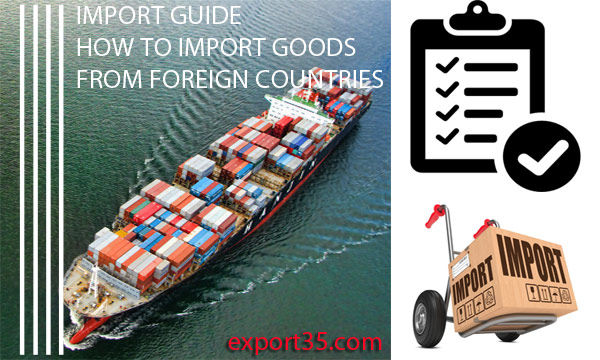Companies importing or importing products, especially for the first time to import products should be careful and detailed research, ...
Companies importing or importing products, especially for the first time to import products should be careful and detailed research, supplier companies and all the details of the product must be carefully analyzed.
Firstly investigate your products and suppliers. Resources available at this stage:
- Sectoral fairs
- Sectoral publications
- Announcements and announcements of exporters' associations
- B2B sites
- Export consulting companies
You will have to evaluate the companies and product groups that you will determine through all these sources and research channels.
DETERMINATION OF PRODUCT AND SUPPLIER STANDARDS
Check out the official websites of the products and exporters you plan to import first. Check out the online catalog, company and product information from sites if available. Check the supplier profile of the manufacturers or vendors you find on B2B sites. A number of B2B sites (for example, Alibaba) support a verification service that enables vendors to be a legally registered company.
This control is performed at 3 locations by B2B sites and / or independent verification companies:
This control is performed at 3 locations by B2B sites and / or independent verification companies:
- Control of company identity,
- Onsite Control,
- Supplier evaluation.
- Verification of Company Identity
All legal business licenses of the companies subject to authentication and the contact details of the departments and authorities such as import, export, customer representative of the companies are verified.
On-Site Control
The company's premises and facilities are verified by the on-site control of the B2B site or verification company personnel, the address information is confirmed. In addition, the legal status of suppliers and other relevant information is verified by a third party verification agency.
Supplier Evaluation
The supplier and its products or services are controlled by independent auditing companies and agencies, if necessary, the products are tested. By means of the necessary evaluation, test and video about the company and its products, it is understood that the products are examined and reported.
Choosing manufacturers that are controlled by B2B sites will mean reducing risks. You have found a supplier that produces the product you are looking for from abroad, agreed on the price, you have calculated all the cost items including freight, insurance, taxes, customs costs, determined your unit cost, you have prepared a contract with all the details, so everything is appropriate but you should not start importing immediately.
Always ask for a sample product, post-production and before shipment, ensure that a surveillance company checks the products and shipment.
Sample Product Request
Always request sample products from exporters. Depending on the type of product, the necessary analysis report, test report and quality documents as well as documents.
Surveillance companies, quality control and shipment control
Supplier visits, oversight services, etc. are often ignored by importers, all of which are extra expense items, but prevent unexpected surprises. The products you import have reached your warehouse, but you have determined that they are manufactured in accordance with the standards you have agreed, or that they are produced incorrectly or that there are missing shipments.
It is a painful process if the post is both difficult and the manufacturer does not accept the mistake. Deal with the quality control of the products produced, before the shipment to be shipped with an inspection firm that will physically check the products to be shipped.
It is a painful process if the post is both difficult and the manufacturer does not accept the mistake. Deal with the quality control of the products produced, before the shipment to be shipped with an inspection firm that will physically check the products to be shipped.
Total cost in imports
Before you make an import decision, you need to estimate all cost items, including freight, insurance, taxes, customs charges, as well as your product and supplier research, and find your total cost per unit. At this point, as far as the current prices of your competitors, investigate price fluctuations in the past year. As a result, you need to determine the profit margin that you can add on the total cost and the basic criterion for the import decision of a product is the quality and price balance.
INFORMATION AND CONTRACT FOR THE EXPORT
The basic information you should get when you contact the supplier:
A) Minimum Order Quantity (MOQ - Minimum Order Quantity)
B) Sample price
C) Product price (Product price)
D) Production Time
E) Payment Terms (Payment Terms)
F) Delivery forms (Incoterms)
Contract, purchase form and proforma invoice
Submit your import request by organizing a purchase order. Make a sales agreement with the following details and request a corresponding proforma invoice.
Product details, product standards,
Production conditions, production time
Price, method of payment,
Label, packaging, pallet standards,
Which language will be arranged in the documents,
Shipment tool, shipment date, shipment time
Warranty terms and conditions
After completing all these processes with the exporter company and after the shipment has occurred, request the draft documents of the original documents and check the originals carefully before printing. It is important that you make sure that the documents such as the bill of lading, origin, ATR, etc. will be re-arranged so that they are prepared correctly.
After shipment, if you did not organize the shipment, ask the shipping company's contact details for your country agent.
Missing Details In Import Process: Reasons for Delayed Shipments
There are many reasons for delays in international shipments. Some of them are due to seasonal or regional conditions. For example, 40% of the delays in UPS and FedEx statistics show that the delays experienced in snowy and heavy rainy days in regions where it is harsh in winter are due to weather conditions. Compared to the city center, unexpected delays are experienced in 50% of the deliveries to the countryside and especially the settlements in mountainous regions.
In overseas shipments, the measurement of deadline performance is mostly provided by the statistics obtained from the shipments of international courier companies. The basic parameters in international logistics, including sea and road transport, the timely loading of the cargo to be transported, the timely departure of the vehicle, the estimated travel time of the vehicle, the process of the cargo at the arrival customs and the delivery time of the cargo to the final address after the customs procedures are completed.
When these parameters are examined, the delay experienced in the process we call delivery time is associated with carrier performance and weather conditions.
Statistics of global shipping companies (mostly courier companies such as DHL, UPS, FedEx) show that if we exclude delays due to seasonal & geographical conditions, % 80 of the delays are due to wrong or incomplete documentation processes due to shipper or receiver. It is included in this statistic because it is due to deficiencies in information and documents due to the late customs clearance made by the buyer or the information requested by the carrier.
Let's talk about one more point, the main reason for delays recorded as recipient unavailability is the incomplete or inaccurate information of the recipient's contact details, ie basically incorrect or incomplete information.
There are many reasons for delays in international shipments. Some of them are due to seasonal or regional conditions. For example, 40% of the delays in UPS and FedEx statistics show that the delays experienced in snowy and heavy rainy days in regions where it is harsh in winter are due to weather conditions. Compared to the city center, unexpected delays are experienced in 50% of the deliveries to the countryside and especially the settlements in mountainous regions.
In overseas shipments, the measurement of deadline performance is mostly provided by the statistics obtained from the shipments of international courier companies. The basic parameters in international logistics, including sea and road transport, the timely loading of the cargo to be transported, the timely departure of the vehicle, the estimated travel time of the vehicle, the process of the cargo at the arrival customs and the delivery time of the cargo to the final address after the customs procedures are completed.
When these parameters are examined, the delay experienced in the process we call delivery time is associated with carrier performance and weather conditions.
Statistics of global shipping companies (mostly courier companies such as DHL, UPS, FedEx) show that if we exclude delays due to seasonal & geographical conditions, % 80 of the delays are due to wrong or incomplete documentation processes due to shipper or receiver. It is included in this statistic because it is due to deficiencies in information and documents due to the late customs clearance made by the buyer or the information requested by the carrier.
Let's talk about one more point, the main reason for delays recorded as recipient unavailability is the incomplete or inaccurate information of the recipient's contact details, ie basically incorrect or incomplete information.
STEP BY STEP IMPORT PROCESS
How to import, how to start importing, how to research the product to be imported, import taxes, how to calculate all the costs including transportation, we list all the steps to be followed with these brief explanations:
During product and supplier research, check whether there are any free trade agreements between the supplier's country and your country and any other customs-exempt agreements, such as antidumping and similar taxes on a product or company basis.
1- Documentation, Product details, HS code
The product details to be sent should be clearly stated in the documents. To learn the customs tariff code "HSCode", ie "customs clearance code" of the imported products, it is necessary to consult the exporting company, then verify this code through a customs consultant if possible. After the product definition is made correctly, all the details such as product number, weight, company information etc. should be written correctly and the shipment documents should be prepared completely.
2- Customs duty
After fixing the GTIP, determine the customs tax of the product. Check if there are additional taxes like antidamping. Also, search the necessary documents and permits for importation. Check if there are any prohibitions and restrictions.
3- The transportation
Get a price from exporter company for different delivery options such as factory delivery, port delivery, door delivery. Then, you can investigate the freight yourself and compare it with the prices you get from the company. In particular, the low cost of the products, the cost of freight, the total cost will have a high impact, so search for the most appropriate freight.
4- Insurance
Do not forget to take out insurance for your products to be imported, if the agreed delivery does not include the insurance you will do it. The risks covered by a standard insurance policy will be limited, you can have more comprehensive insurance. Investigate the cost of insurance and the risks involved.
5- Internal shipping
The product you will import will arrive at the port, warehouse or airport depending on the type of transport vehicle abroad and wait here for customs clearance. Then investigate the shipping costs for transport to your company building or warehouse.
6- Customs expenses
Include the costs incurred at the customs clearance stage in your total cost, in addition to the taxes that must be paid for the import. You will have to pay for all the costs incurred, including the cost of customs consultancy, the cost of the warehouse, portcosts etc...
7- Exchange
Review the changes in exchange rates periodically. If the production and transport processes after your order hold a large period of time, it is vitally important for importers to anticipate the volatility in the currency.
















COMMENTS